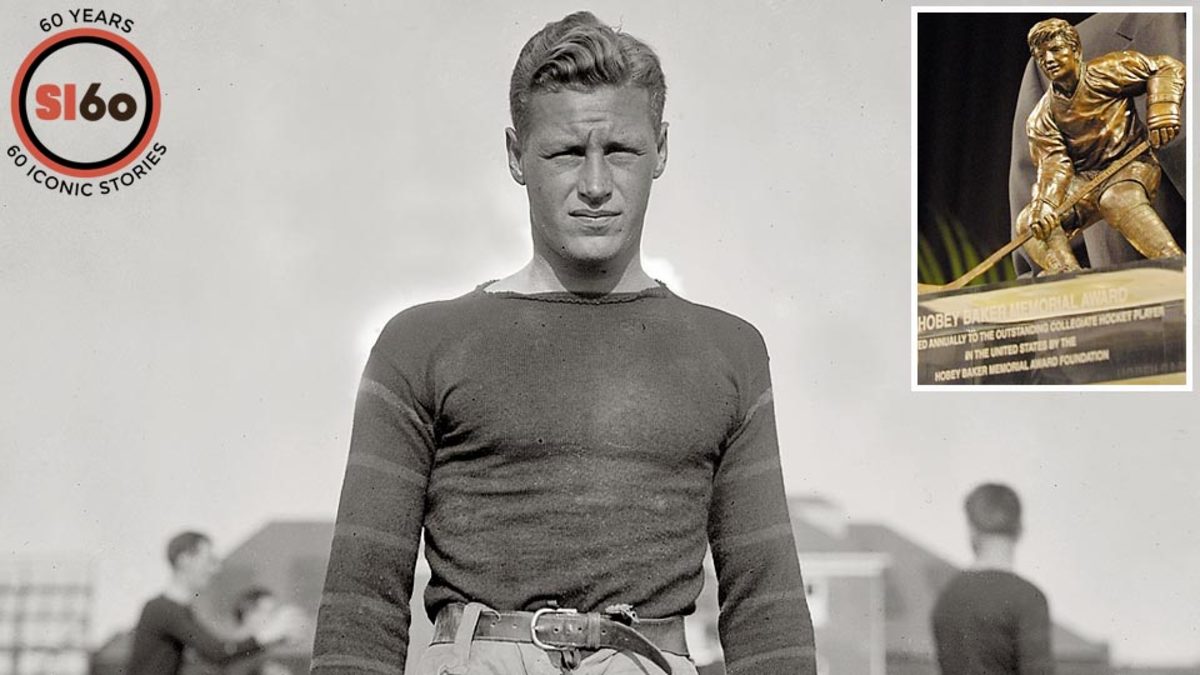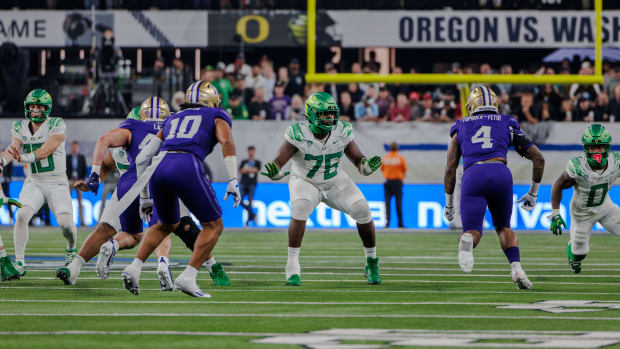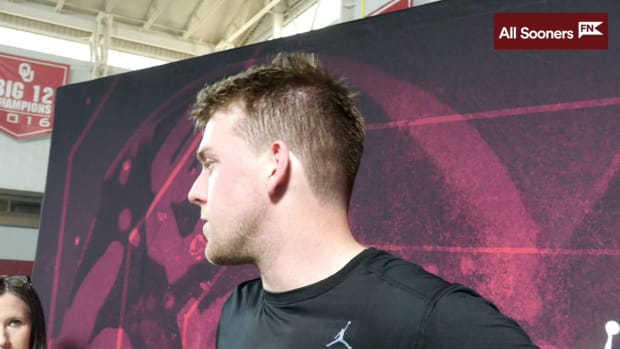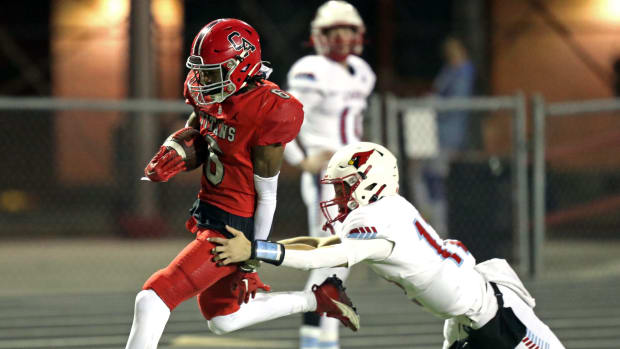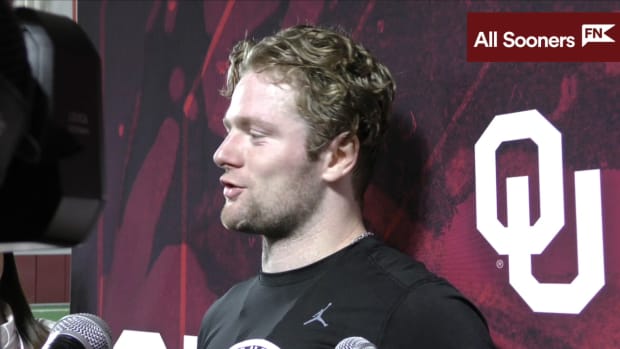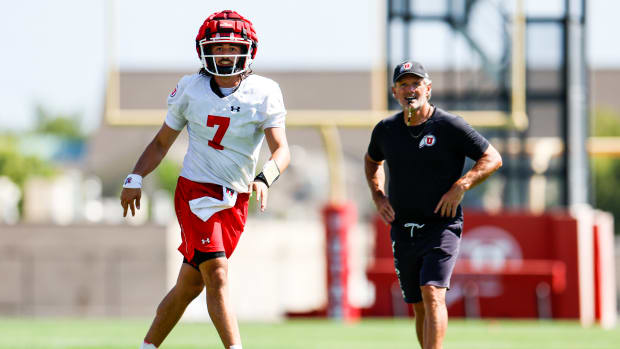A Flame That Burned Too Brightly: Hobey Baker found little to live for after starring at Princeton
In celebration of Sports Illustrated's 60th anniversary, SI.com is republishing, in full, 60 of the best stories to ever run in the magazine. Today's selection is "A Flame That Burned Too Brightly," by the late, great Ron Fimrite, which appeared in the March 18, 1991 issue. It is about Hobey Baker, a football and hockey star at Princeton who was as beloved for his performances on the field as for his grace and style off it. Baker, who was later the basis for a character in an F. Scott Fitzgerald novel, bore resemblances to Fitzgerald's Gatsby, right down to his untimely death.
The headstone is scarcely distinguishable from neighboring prominences on lot 12 in the Rockland section of the vast West Laurel Hill Cemetery in the Philadelphia suburb of Bala Cynwyd. Palatial mausoleums command the hilltop, and even the lesser monuments below are ennobled with flags and wreaths and scattered flowers. But in the winter wind, only dead leaves dance on Hobey's grave. The inscription on his modest stone, shadowed now by the skeletal limbs of barren trees, reads:
HOBART AMORY HARE BAKER
CAPTAIN 141ST AERO SQUADRON, AEF
DIED AT TOUL, FRANCE, DECEMBER 21, 1918
AGED 26 YEARS
It is only the anonymous verse beneath the inscription that suggests the splendor of the man buried here:
YOU SEEMED WINGED, EVEN AS A LAD,
WITH THAT SWIFT LOOK OF THOSE WHO KNOW THE SKY,
IT WAS NO BLUNDERING FATE THAT STOOPED AND BADE
YOU BREAK YOUR WINGS, AND FALL TO EARTH AND DIE,
I THINK SOME DAY YOU MAY HAVE FLOWN TOO HIGH,
SO THAT IMMORTALS SAW YOU AND WERE GLAD,
WATCHING THE BEAUTY OF YOUR SPIRITS FLAME,
UNTIL THEY LOVED AND CALLED YOU, AND YOU CAME.
That he should now lie ignored in the city of his birth is the final irony in the amazing saga of Hobart Amory Hare (Hobey) Baker, in his day and perhaps forever the most romantic figure in all of sport, an athlete who surpassed even his most daring feats with the sheer magic of his person. Hobey is the only athlete elected to both the College Football Hall of Fame and the Hockey Hall of Fame. He is a charter member of the latter, and he was the first American-born player inducted. The Hobey Baker Award is collegiate hockey's equivalent of the Heisman Trophy. Football statistics were considered declasse in Hobey's time, but the 92 points he scored in 1912 was Princeton's single- season record for the 20th century until 1974.
But Hobey was much more than the sum of his achievements. He was the beau ideal of American sport, a hero in every particular. He was, by our standards, a small man, only 5 ft. 9 in. and 160 pounds, but not so small at a time when the heaviest of football linemen weighed barely 200 pounds. And he was so flawlessly proportioned, so impossibly graceful in body and manner, that he seemed to tower over his fellows. With wavy blond hair and soft blue-gray eyes, he was among the handsomest of men, so disarming in appearance that his contemporaries at Princeton were not embarrassed to call him beautiful. Add to all this a humble manner, a noble character and what his biographer, John Davies, calls ''a foreboding, a sense that Hobey was somehow playing out a Greek tragedy,'' and you have the stuff of literature.
SI 60: Kentucky: May: Saturday
F. Scott Fitzgerald, who entered Princeton in the fall of Hobey's senior year, 1913-14, saw him as ''an ideal worthy of everything in my enthusiastic admiration, yet consummated and expressed in a human being who stood within ten feet of me,'' according to Davies. It is no accident that the protagonist of Fitzgerald's first novel, This Side of Paradise, is named Amory Blaine or that Hobey should appear as a character named Allenby. Fitzgerald describes Amory sitting on the steps of his Princeton rooming house as ''a white-clad phalanx'' of singing students passes by: ''There at the head of the white platoon marched Allenby, the football captain, slim and defiant, as if aware that this year the hopes of the college rested on him, that his hundred-and- sixty pounds were expected to dodge to victory through the heavy blue and crimson lines.''
Fitzgerald biographer Andrew Turnbull wrote that in the Princeton of that time, ''varsity football players were looked upon as demi-gods, and 'Hobey' Baker . . . loomed so high in the heavens that he was scarcely visible. But Baker had the common touch. Now and then he came down from Olympus to fraternize with the freshmen, and Fitzgerald actually spoke to him one day in October.''
John Tunis, author of innumerable sports novels for boys, found the inspiration for his immaculate heroes in Hobey. Tunis wrote: ''The whole atmosphere was electric when ((Hobey)) was playing. Everybody would just stand up when he got the puck or caught the punt. Never wore a headguard in football, and I remember that great shock of blond hair -- Hobey standing waiting all alone. He was the only player on the field you looked at, the only player you saw. . .. He did everything with a kind of showmanship that wasn't showmanship because it was natural to him. He was a kind of panther. His coordination and footwork were so wonderful that he could take chances and do things that others wouldn't dare to. . . . He would drop-kick, tackle and run with a kind of feline intelligence, grace and charm -- he would make everything look so easy. Never was anybody like Baker."
Mark Goodman, who explored the Hobey legend in his 1985 novel, Hurrah for the Next Man Who Dies, wrote, ''((Hobey)) carried his prowess with him everywhere, lightly like a sorcerer's cloak woven of school colors. . . . Not only was he incapable of dirty play, he was all but incapable of acknowledging it until it quite literally bit him. Then the pain of it -- not the physical pain, for nothing ever really hurt him, but the unimaginable specter of muckery – could move him to tears.''
Hobey has a walk-on part in Geoffrey Wolff's 1990 novel, The Final Club, which chillingly describes the Princeton practice called Bicker, in which the eating clubs tap new members. One of Wolff's characters, Booth Tarkington Griggs, tells Ivy Club friends about his dead father: ''You know his name was Hobart? Called after Hobey Baker, a first cousin. . . . Lafayette Escadrille in Double-you-Double-you-One, fiery plunge to chilly Styx in same; he also did a star turn in this place. Hockey. Ditto Daddy. Ivy. Ditto.
So I'm a legacy. Here and at Ivy.''
George Frazier, the brilliant Boston essayist, wrote in 1962 of Hobey and Princeton: ''. . . he haunts a whole school, and from generation unto generation. You say, 'Hobey Baker,' and all of a sudden you see the gallantry of a world long since gone -- a world of all the sad young men, a world in which handsome young officers spent their leaves tea-dancing at the Plaza to the strains of the season; a world in which poets sang of their rendezvous with death when spring came round with rusting shade and apple blossoms filled the
air.''
The Ring Leader: Bill Russell helped the Celtics rule their sport like no team ever has
But Hobey's influence extended far beyond the printed page. Through his spartan example, he imposed a code of behavior on athletes, particularly college athletes, that was accepted, if not faithfully observed, for the better part of four decades. It is now, alas, as forgotten as the dropkick. In the Hobey code, for example, a star player must be modest in victory, generous in defeat. He credits his triumphs to teamwork, accepts only faint praise for himself. He is clean-cut in dress and manner. He plays by the rules. He never boasts, for boasting is the worst form of muckery. And above all, he is cool and implacable, incapable of conspicuous public demonstration. No room there for the Ickey Shuffle.
The Hobey code -- unspoken, for to speak of it would be another form of muckery -- was far-reaching in its time. Lou Gehrig and Joe DiMaggio observed it. So did Joe Louis and Rocky Marciano. Nile Kinnick, the 1939 Heisman Trophy winner, who also died young, embodied it. Roger Staubach adhered to it. And so, for all his flair, did Julius Erving.
But, as Tunis correctly observed, there ''never was anybody like Baker,'' and considering the opposite road most contemporary athletes seem to be following, there never will be again. Hobey was the gentleman-sportsman, the gifted amateur in the English tradition he so admired. And as another Fitzgerald biographer, Arthur Mizener, has written, ''With his almost incredible skill and grace, his perfect manners, his dedicated seriousness, Hobey Baker was the nearly faultless realization of the ideal of his age.'' And yet, there was always the dark side: the realization that this was a flame burning too brightly to burn long. Hobey Baker had a fault: he was mortal, and he refused to accept the condition.
Smart lad, to slip betimes away
From fields where glory does not stay
And early though the laurel grows
It withers quicker than the rose. . . .
Now you will not swell the rout
Of lads that wore their honours out,
Runners whom renown outran
And the name died before the man.
-- A.E. HOUSMAN
To an Athlete Dying Young
From ''A Shropshire Lad'' -- Authorized Edition -- from THE
COLLECTED POEMS OF A.E. HOUSMAN. Copyright 1939, 1940, (c) 1965 by
Holt, Rinehart and Winston. + Copyright (c) 1967, 1968 by Robert E.
Symons. Reprinted by permission of Henry Holt and Company, Inc.
Hobey Baker was born on Jan. 15, 1892, the second son of Alfred Thornton Baker, a socially prominent Philadelphian whose money came from the upholstery business, and Mary Augusta Pemberton, a Philadelphia society belle. Hobey was named after his maternal uncle, Dr. Hobart Amory Hare, the presiding obstetrician at his birth and, at that time, president of the Jefferson Medical Hospital. Hobey's father was a popular man about town, a member of all the right clubs: the Racquet, the Rittenhouse, the University and, most exclusive of all, the Fish House, founded in 1732 and limited in membership to 30 Philadelphia gentlemen. The senior Baker -- Bobby to his friends -- had been a halfback at Princeton in the 1880s, and his father had also been a son of Old Nassau.
In 1903, when Hobey was 11, he and his brother, Thornton, one year older, were sent to St. Paul's School in Concord, N.H.; founded in 1855, St. Paul's was among the oldest of the elite East Coast prep schools and was the model for such successors as St. Mark's and St. George's. ''What is the spirit of St. Paul's?'' Arthur Stanwood Pier asked in St. Paul's School, 1855-1934, the history he wrote in 1934.
''In the accepted meaning, the boy who has school spirit, the right attitude, is one who conforms cheerfully to regulations and customs .. . is energetic and enthusiastic in club athletics, is pleasant and friendly with masters and never two-faced with boys, and is quite uncritical in his outlook.''
SI 60: 'Lawdy, Lawdy, He's Great'
St. Paul's in Hobey's time was also the cradle of the newly popular sport of ice hockey, which had been brought south from Canada a few years earlier. The St. Paul's coach, Malcolm Kenneth Gordon, whom some have called the father of American hockey, learned early on that in Hobey he had a phenomenal player. Hobey had astonishing speed on the ice and the grace of a figure skater. He also worked hard at the game, skating on frozen ponds in the dead of night to practice carrying the puck without looking at it. He made the St. Paul's varsity at age 14 and was soon leading it to upset wins over the best amateur teams -- college and club -- in the East. In the 1909-10 season, when Princeton went 7-3 against college teams, it lost 4-0 to Hobey and St. Paul's. The season before, St. Paul's had defeated Harvard 5-3 with Hobey time and again stealing the puck from the Crimson captain, Clarence Pell. In his 1966 biography, The Legend of Hobey Baker, Davies, a former professor of history at Princeton, quotes one of Hobey's St. Paul's teammates: ''[Hobey] flew over the surface like a bird. . . . I had seen pros play in Pittsburgh where I had first played hockey, but I had never seen such speed nor such grace."
He was beyond question the best hockey player in the history of St. Paul's. He may still be. But there was no sport Hobey could not master. He was already a brilliant broken-field runner and kicker, as well as a fine outfielder. He was an accomplished gymnast, swimmer and diver. He could juggle five balls. He could walk up flights of stairs on his hands. He was a fast sprinter, but he also excelled at cross-country running. He put on roller skates for the first time and within five minutes was doing stunts on one foot. One St. Paul's master told Davies, ''((Hobey)) had perfect control of himself and could bring every muscle of his body to bear at one time.'' He was also the most popular boy in school, a member of the elite Bogi society. He was, in fact, already a legend.
St. Paul's had by this time become both home and family for him. In 1907, his parents divorced, virtually abandoning Hobey and Thornton to school and relatives. The boys' father also suffered severe financial reverses in the economic crisis of '07. In his reduced circumstances, he could send only one of his sons on to college, and Thornton, keenly aware of Hobey's exceptional gifts, gallantly stepped aside, a beau geste Hobey never forgot. But there wasn't even enough money for one Baker to attend college in 1909, so Hobey stayed at St. Paul's an extra year. In the fall of '10, he began his fabulous career at Princeton.
He saw the school much as Fitzgerald's Amory Blaine would see it: ''From the first he loved Princeton -- its lazy beauty, its half-grasped significance, the wild moonlight revel of the rushes, the handsome, prosperous big-game crowds, and under it all the air of struggle that pervaded his class . . . that breathless social system, that worship, seldom named, never really admitted of the bogey 'Big Man.' ''
In no time Hobey became that Big Man on campus. As a member of the freshman football team, he beat Yale 6-0 by faking a dropkick field goal and speeding to the game's only touchdown. He was an outfielder on the freshman baseball team and, of course, a wonder in hockey. But the Princeton rules of the day let him play only two varsity sports, so he chose football and hockey, which bore only superficial resemblance to their present incarnations.
Football had changed from the legalized warfare of its pioneer days to a somewhat more civilized activity because, in 1905, President Theodore Roosevelt had advised college officials either to make it safer or to discontinue it. New rules were therefore conceived and gradually introduced. The lethal flying wedge was outlawed, and seven offensive players were required to be on the line of scrimmage at all times. The forward pass was also permitted, but because of the plumpness of the ball, it was seldom attempted. And after 1912 a first down could be made by advancing 10 yards in four plays (instead of the original three). The result of these changes was a much more defensive style of play than in the flying-wedge days and an emphasis on the kicking game. The prevailing strategy was simply to kick and wait for the breaks. A team might punt 40 or more times a game, frequently on first down, hoping for a fumble or a misplay. The dropkick field goal was scored far more often than the touchdown.
In this system the two most important players on the team were a sure-handed safetyman and an accurate dropkicker. Hobey was both. As a safety, he often gained more yardage returning punts during a game than both teams did on offense, and as a kicker, he was nearly the equal of his contemporary at Harvard, the great Charley Brickley.
Hobey had a unique method of fielding punts: He would first size up the flight of the ball and then step back far enough so that he could catch it on the dead run. It was a tactic that repeatedly broke him free for long gains. Against Yale in 1912, he had a sensational runback of 88 yards. Most players at that time wore at least rudimentary helmets, but not Hobey, who considered headgear too confining. Although there was no contesting the genuineness of his modesty, there was a streak of narcissism in him, and it may be assumed he was not uncomfortable being known as ''the blond Adonis of the gridiron.'' His golden hair became his ensign. When joyful spectators cried out, ''Here he comes!'' there could be no doubting the object of their excitement.
And they could count on Hobey to deliver the goods. In his first year on the varsity, Princeton won the Big Three championship (defeating Harvard and Yale) and was, according to football historian Parke Davis, the top team in the country. The Tigers were 20-3-4 in Hobey's three varsity seasons.
Hockey was a seven-man game in Hobey's day. There was no forward passing, and substitutions generally occurred only after injuries. The key offensive player was the rover, Hobey's position. ''His characteristic play . . . was to take a rebound or steal the puck at his own end, and while forwards scrambled to get into position, he would circle the goal -- sometimes twice -- to pick up momentum and then take off at high speed,'' writes Davies. ''One of the odd things about playing against Baker . . . was that because of his looping, curving pattern of maneuver, on one of these solo dashes a defenseman might get two or even three cracks at him.''
Hockey was nearly as rich a showcase for Hobey's talents as football, because, lacking a rink of its own, Princeton played many of its games in big- city arenas, notably the St. Nicholas in Manhattan, where the socially prominent debouched in evening finery from limousines and carriages as if attending a cotillion. Lawrence Perry, a sportswriter for the New York Post, described a typical scene: ''A line of limousines would stretch from Columbus Avenue to Central Park West on 66th Street. A most fashionable audience would be inside, drawn solely by Baker's appearance. Men and women went hysterical when Baker flashed down the ice on one of his brilliant runs with the puck. I have never heard such spontaneous cheering for an athlete as greeted him a hundred times a night and never expect to again.'' Hobey was a marked man in every game he played, but legend has it that he never retaliated for the rough stuff inflicted upon him.
Princeton's official record during Hobey's three varsity years was 27-7. And yet his greatest collegiate game was probably a loss, to Harvard in January 1914. The game lasted 73 minutes (including 10 minutes of overtime and 23 minutes of sudden death) before Princeton succumbed 2-1 on a goal scored by Leverett Saltonstall, later the governor of and a U.S. senator from Massachusetts. In the overtime Harvard substituted freely for players collapsing from exhaustion, but Hobey played the entire 73 minutes and was skating as fiercely at the finish as he had at the start.
At Princeton, Hobey majored in the department of history, politics and economics, and his grades were solidly in the second group, the equivalent of a B average. In the classroom he was known more for diligence than for brilliance. He enjoyed having a drink and a song or two with the gang down at the Nassau Inn, but a couple of beers was pretty much his limit. Hobey could become giddy after a single beer, and on occasions when he took in too much champagne, he became dangerously adventurous. After one too many at a party in New York, he briefly crawled out onto a narrow window ledge on a high floor of the Plaza Hotel.
He lived with six other St. Paul's classmates, at 82 Nassau Street, above what was then Renwick's restaurant, and took his meals at the Ivy, the oldest (1879) and most revered of 16 eating clubs then at Princeton. Ivy was ''detached and breathlessly aristocratic,'' Fitzgerald wrote, but Hobey was no snob. One classmate, J. Henry O'Neil, timorous in Hobey's presence but eager to have his parents meet the great athlete, called out to him as he sped by on his bicycle. ''He skidded his bicycle to a stop, put it down on the grass and came trotting back to us, saying, 'Gee, I was afraid you weren't going to stop me,' '' O'Neil wrote to Davies.
SI 60: 1954-94: How We Got Here Chapter 1: The Titan of Television
At his graduation in 1914, Hobey was named ''the man who has done most for Princeton,'' among sundry other honors, including those of best football player and best hockey player. But Princeton may have done too much for Hobey. Like Fitzgerald's Tom Buchanan in The Great Gatsby, Hobey had become ''one of those men who reach such an acute limited excellence at twenty-one that everything afterwards savors of anticlimax.'' Hobey said as much to a friend, James M. Beck. ''In reminiscing about college days,'' Beck wrote Davies, ''[Hobey] suddenly became very serious and said, 'I realize that my life is finished. No matter how long I live, I will never equal the excitement of playing on the football fields.' ''
Hobey eventually did what was expected of a gentleman of his class: He joined the firm of J.P. Morgan on Wall Street. But the job bored him almost beyond endurance. ''Think of all the things I could do today if I didn't have to go to work,'' he lamented to a friend. He relieved his boredom by playing hockey for St. Nick's, an amateur team made up primarily of Big Three graduates that he transformed, in the newspapers' term, into Baker & Co. He cringed at marquees that announced HOBEY BAKER PLAYS TONIGHT and did his best to discourage excessive publicity. ''I'd rather you wrote nothing, sir,'' he told one inquiring newspaperman. But since St. Nick's often played professional teams from Canada -- and usually won -- Hobey's fame soon spread across the border. Lester Patrick, who played for the Montreal Wanderers in 1905 and '06, when they won the Stanley Cup, and managed the New York Rangers two decades later, said Hobey was the only amateur he ever saw who could have played professional hockey and been a star in his first game. Harry Hyland, who played for the Wanderers in Hobey's time, said, ''Baker stands out so far above your other American players as to make comparisons ridiculous.''
Hobey also palled around New York with the enormously rich playboy Percy Pyne, a St. Paul's and Princeton man 10 years his senior. Pyne loaned Hobey his valet so that after a hockey game at St. Nick's, Hobey might change quickly into evening clothes for the night's revels. Under Pyne's influence, Hobey took up polo and auto racing and excelled in both sports. And through Pyne he met the glamorous New York society girl Jeanne Marie (Mimi) Scott, to whom he would be briefly, and with much publicity, engaged.
In his restlessness Hobey developed another, this time all-consuming, passion. In 1916 he became interested in flying and joined Gen. Leonard Wood's civilian aviation corps, taking lessons in the late afternoon on Governor's Island after working a full day on Wall Street. On one occasion he buzzed a Yale-Princeton football game, flying low over a cheering crowd that quickly recognized the blond head in the cockpit. The war in Europe was in its third year when Hobey became a lieutenant in the U.S. Army in May 1917. On Aug. 23, nearly five months after the U.S. declared war on Germany, he went to France, and by December he was training in aerial gunnery at Issoudun. He was accepted into the fabled Lafayette Escadrille, which became the 103rd Aero Squadron.
In flying, Hobey found the perfect outlet for his adventurous spirit. And for his athleticism. Piloting planes so light they were little more than extensions of his body, he could maneuver much as he had while returning punts or racing across the ice. The connection with sport was hardly lost on him. ''You handle your machine instinctively just as you dodge instinctively when running with the ball in an open field,'' he wrote home from France. Combat pilots on both sides observed the code by which Hobey lived. They were chevaliers of the skies fighting one-on-one battles to the death, honoring the fallen foe with cognac toasts after the battle. Hobey arrived at the front too late for the air wars of Bloody April (1917), when some 180 ; British planes went down in flames. A pilot had to look hard for a dogfight by the time Hobey's group was ready for action. Altogether, Hobey had three kills, two short of the number needed to become an official ace, but he was awarded the French Croix de Guerre after his first kill and cited by the American Expeditionary Force commander, Gen. John Pershing, for ''distinguished service and exceptional gallantry.'' In August 1918, he was promoted to captain and put in command of a new squadron, the 141st. At home, the newspapers declared him a war hero.
Hobey's air war, dangerous though it may have been, had little to do with the horror in the trenches below. In Goodman's Hurrah for the Next Man Who Dies, the protagonist, Jeb Runcible, is shot down and forced to make his way back to the airfield through no-man's-land. ''Oh, God,'' he cries out from the fields of slaughter. ''Oh, God, you dirty mucker!'' Runcible returns to the base to find Hobey and the other pilots celebrating the day's dogfighting at the bar. ''Do you understand this, Hobey?'' he snarls. ''That's not the bloody ---- Yale game out there.''
The real-life Hobey may have been unclear on this point too. To him the war was a game, and when it ended in November 1918, he felt a sense of loss and disappointment, for he had not had his fill of it. And once more he was confronted with the galling prospect of getting on with the rest of his life. By now he was convinced that he was totally unsuited for so-called adult occupations. He was a sportsman, not a businessman. Nearly 27, he considered himself without prospects.
In December he received his orders to go home. But to what? On the 21st, the day he was scheduled to leave on the night train for Paris, he told his incredulous comrades that he would take ''one last flight in the old Spad.'' This violated both tradition and superstition. ''One last flight,'' in pilot's lore, was feared to be just that. But Hobey was the commanding officer, and though his subordinates protested vigorously, he would not be dissuaded. As he reached the hangar and before he could call for his own Spad No. 2, a mechanic informed him that No. 7, a plane whose carburetor had failed in flight a few days earlier, was ready for testing. As squadron commander, Hobey decided it was his duty to take the plane up for a checkout flight. ''I'll take No. 7,'' he said. His last symbolic gesture would now be made in a borrowed and possibly defective plane. He had placed himself in double jeopardy.
The Importance Of Being Barry: The best player in baseball? Barry Bonds. (Just ask him.)
He took off in a heavy rain, executed a chandelle (steep climbing turn) and leveled off at 600 feet. After a quarter of a mile, the engine quit. The Spad, for all of its faults, had one redeeming feature when it was in trouble: It was easy to crash-land. Hobey himself had crash-landed in rugged terrain only a month before. But this time he did not try for the forced landing. Instead, he acted as if he were trying to bring the stalled plane back to the air base. He made a right turn and pushed the stick forward to regain flying speed. Another hundred feet of altitude and he might have been able to get the nose of the plane back up. But he didn't have that hundred feet. The plane crashed nose down only a few hundred yards from the hangar. His own men freed him from the wreckage, and he died in the ambulance a few minutes later.
Back home, Perry wrote in the Post: ''It is with emotion too poignant for orderly thought or precise expression that I write of Hobey Baker, whose death last Saturday, through the falling of his airplane at Toul, has just been announced. I don't think anyone who knew Hobey Baker personally, or as an athlete, will have any feeling other than that he was qualified to stand aloof as the ultimate product of all that is worthy, not alone in American college athletics, but in American college life.''
But there were other reports from France implying that Hobey's death was not entirely accidental. Those who knew him well were aware of his misgivings about returning to the humdrum workaday world. And though Hobey had no way of realizing this, the world he had known before the war, the world he had conquered with such style and grace, would forevermore be changed. The slaughter in the trenches had created a new cynicism. Gallantry now seemed irrelevant, courage foolhardy. The gentleman was to be replaced by a new species of American: the go-getter. Hobey Baker and George Babbitt could scarcely be expected to coexist.
Better perhaps to die dramatically. After all, why had he taken that damaged plane up? And why had he not attempted a crash landing? ''I talked to some of his surviving relatives,'' Davies says, ''and they as much as said, 'If Hobey had not gone down in flames, what would have become of him?' '' But Davies believes Hobey was too proud
to take his own life.
Goodman's fictional Runcible gives Hobey a bitter epitaph: ''Hobey Baker drew his only sustenance from the strength and beauty of his own body . . . the narcissist incarnate, driven finally by his own tragic excellence to wed his perishable body to an indifferent machine and a threadbare code. Finally, it made a fool of him. A gifted fool, even a fabulous fool, and a far better man than I; but a fool nonetheless. Hobey didn't commit suicide on the fields of France. . . . But his physical egotism conspired with his sense of duty to destroy him, so it amounted to the same thing. With his last gesture he had to do the right thing by his office, as well as beat the odds one more time; and so he died in that fractious little plane as hopelessly, needlessly, as Ahab had died lashed to his terrible whale.''
Hobey has left his traces at Princeton. The great gray Gothic hockey rink there is the Hobart A.H. Baker Memorial Rink. Inside, he is depicted in his airman's tunic and Sam Browne belt. In the tap room of the Nassau Inn, where Hobey drank beer and sang Moonlight Bay with the gang, his photograph hangs between those of two other Princeton athletic giants, Bill Bradley, the basketball star of the 1960s who is now a U.S. senator, and Dick Kazmaier, the '51 Heisman Trophy winner. A painting of Hobey hangs in the living room of the Ivy Club, where both men and women now gather. Of the 360 men in Hobey's class of 1914, only four are still living, and three are infirm. The one who definitely is not is C. Earl Moore, a retired investment officer in Rosemont, Pa. Moore is 97. He remembers Hobey well:
''Hobey Baker? Oh my, what a wonderful boy he was. Just wonderful. You know, I used to play hockey in prep school, but when I came to Princeton and saw Hobey and all those St. Paul's boys play, I realized I should give up that game. And what a football player he was. You never knew what he'd do next, and if it was third-and-long, you just knew he'd make it. He loved speed. That's why he became a flier in the war, you know.
''He spent so much time playing and practicing that we never saw him much on campus, but, well, he was just the star of our class, of the whole school. His circle of friends was not my circle of friends, but whenever I saw him, he always had a smile. I don't really know how to describe him. He was such an attractive man. He was so humble, he'd never talk about anything he ever did in sports. He was a gifted athlete if ever I've seen one, and a good student. He had such a fine disposition. Oh, I don't think there was anyone at Princeton who didn't wish he knew Hobey better. He was so many things to us. But above all, yes, above all, he was a gentleman.''
Moore leans forward. His eyes are moist. ''You know, Hobey's grave is only a few steps away from my family plot at the West Laurel Hill Cemetery. And whenever I go there to visit my family, I always make it a point to stop by Hobey's grave for a few minutes to pay my respects. At Christmas I'll place a wreath there, because there is never anything on that grave. No flowers, just leaves. It's a beautiful headstone, but it just gets no attention. Sometimes the leaves aren't even raked. Sad, real sad. And there's a poem there. I know the last few lines by heart.
I think some day you may have flown too high,
So that immortals saw you and were glad,
Watching the beauty of your spirits flame,
Until they loved and called you, and you came.
Well, I'll stand there and read those beautiful lines, and I'll know he's there under my feet, and I'll look down and I'll say, 'Oh, Hobey, why? Why, Hobey, why?' '' Moore clears his throat. ''And there's no answer, you know. There never will be.''
